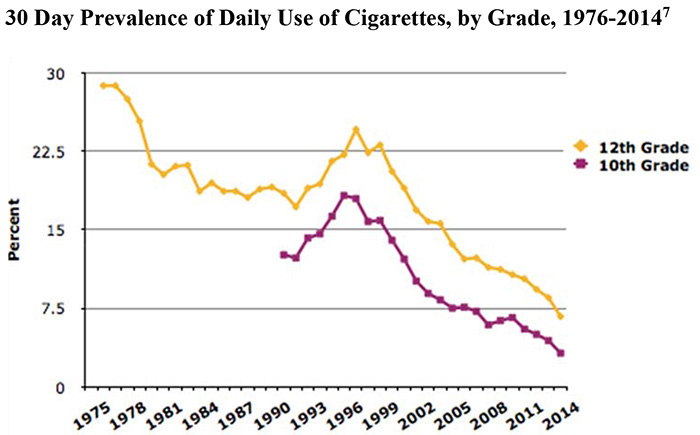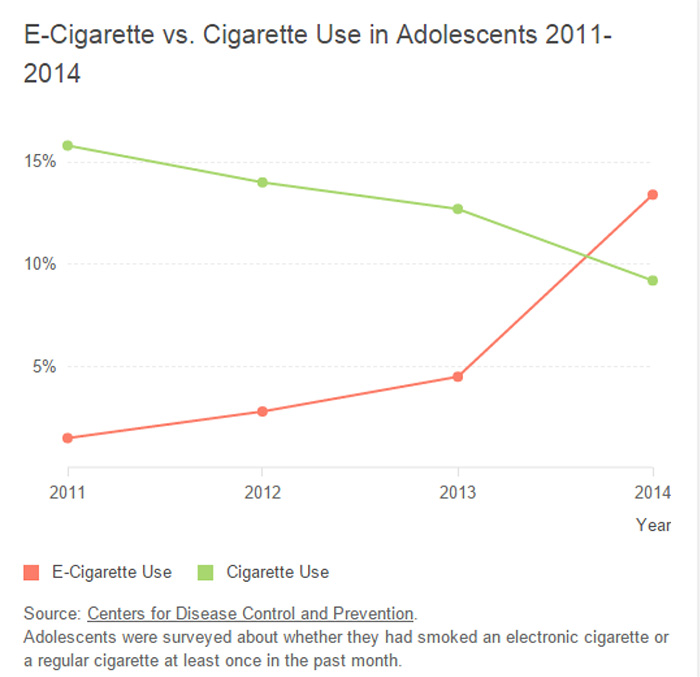Comments On Proposed Study Of E-Cigarettes (FTC File No. P144504)
December 23, 2015
Federal Trade Commission
600 Pennsylvania Avenue, NW Washington, DC 20580
Re: Comments on Proposed Study of E-Cigarettes (FTC File No. P144504) To Whom It May Concern:
I applaud the Federal Trade Commission (FTC) for proposing a study of electronic cigarettes. As the comment period comes to a close, I write to urge the Commission to focus extensively on the industry’s efforts to implicitly or explicitly market e-cigarettes to minors and to ensure that these campaigns are in strict compliance with federal truth-in-advertising laws.1
Since 1998, marketing cigarettes to minors has been illegal in the United States, but the same companies that peddled “Joe Camel” and similar, kid-friendly images to an earlier generation are back with new ad strategies that appear to target e-cigarettes just as explicitly toward children and teens, with little or no regard for any potential health impacts.
New York City is proud to have been a national leader in the fight to limit the public health effects of tobacco. In 1990, New York became the first large city in the country to ban cigarette vending machines from most public places as part of a broader campaign that sought to bar cigarette advertisements on mass transit and replace such advertising on city-owned billboards with anti-tobacco messaging.2 These efforts have helped to reduce the use of tobacco by New Yorkers of all ages—saving countless lives and billions of dollars in health care spending.
As Comptroller, I am the City’s Chief Financial Officer—tasked with highlighting potential risks to public health and safety that could undermine the public fisc and undermine our economic competitiveness.
I also oversee the City’s pension funds, which have $160 billion in assets and a history of encouraging tobacco companies in our portfolio to manage the legal, regulatory and reputational risks associated with their products. Consistent with these efforts, the City’s pension funds have long supported efforts to prohibit marketing of cigarettes to minors. The advent of e-cigarettes raises analogous concerns/risks.
While the complete health impacts of e-cigarettes are not yet known, there is a clear consensus concerning the damaging effects of nicotine on adolescent brain development. As a result, we must fully understand how e-cigarettes are being marketed to our youth and take immediate action to protect our children from the danger posed by new nicotine delivery devices.
Analysis
In 1981, a market research report from Philip Morris declared, “It is important to know as much as possible about teenage smoking patterns and attitudes. Today’s teenager is tomorrow’s potential regular customer and the overwhelming majority of smokers first begin to smoke while in their teens.”3
Indeed, for decades, the tobacco industry had specifically crafted marketing campaigns to appeal to what R.J. Reynolds called, the “fragile, developing self-image of the young person.”4 Companies exploited the appeal of celebrities and cartoon characters, in addition to targeting advertisements to locations and media popular with young people.
As you know, pursuant to the 1998 Master Settlement Agreement (MSA) between 46 state Attorneys General and major tobacco companies, the industry is slated to pay approximately
$200 billion over the first 25 years, with additional payments being made in perpetuity.5
In addition to those payments, the MSA also laid out a series of steps that the industry must take to address marketing to minors, including banning:
- Cartoons in the advertising, promotion, packaging or labeling of tobacco
- Industry actions aimed at initiating, maintaining or increasing youth
- Most outdoor advertising, including: billboards, signs and placards in arenas, stadiums, shopping malls, and video game
- Advertising of tobacco products on transit (buses, trains, ).
- Distribution and sale of apparel and merchandise with brand-name logos (caps, T-shirts, backpacks, etc.).
- Payments to promote tobacco products in movies, television shows, theater productions or live performances, live or recorded music performances, videos and video
- Brand name sponsorship of events with a significant youth audience or team sports (football, basketball, baseball, hockey or soccer).
- Sponsorship of events where the paid participants or contestants are underage.
- Tobacco brand names for stadiums and arenas.
- Free samples except in areas where the operator ensures no underage person is present.
The results of these efforts have been nothing short of extraordinary. As shown below, since the MSA was signed in 1998, tobacco use among teenagers has fallen precipitously.
Between 1998 and 2014, the share of 8th graders reporting that they smoke cigarettes daily has fallen by 84 percent, while the share of 10th and 12th graders who smoke daily has fallen by 80 and 70 percent, respectively.6
“Occasional” smoking by adolescents has also plunged, with 8 percent of U.S. 8th, 10th, and 12th graders reporting smoking at least once in the past month in 2014, down from 28 percent in 1997-1998.
These achievements have saved thousands of lives and billions of dollars in medical costs associated with tobacco use.
However, instead of adopting these tools to the rise of e-cigarettes, the industry appears to have harkened back to an old playbook—one that explicitly and implicitly targets minors as a source of potential revenue.
Indeed, a major concern for public health officials is that the industry’s marketing strategies for e-cigarettes are remarkably similar8 to the types of strategies banned under the MSA, including:
- Sponsoring summer concert events
- Advertising in magazines
- Sponsoring NASCAR drivers (including free samples at events)
- Using celebrity endorsers
- Advertising sweet flavors9
- Using cartoons, including Santa Claus10
An appendix attached to this testimony showcases the similarities between marketing of traditional tobacco pre-MSA and e-cigarettes today. Many of the advertisements shown were compiled by the Campaign for Tobacco Free Kids.
As a result of this marketing, it comes as no surprise that a recent report found that the vast majority of American youth—more than 80 percent—are exposed to e-cigarette advertising.11
The report also found that marketing for e-cigarettes is booming and that the big players are brands largely controlled by the nation’s largest tobacco companies.
- The top 10 e-cigarette brands with the highest advertising expenditure in 2013 and 2014 account for 98 percent of total category spend.
- Five brands (blu, MarkTen, NJOY, Vuse and Fin) account for 95 percent of total category spend. The three brands with highest advertising expenditure in 2014 — MarkTen, blu, and Vuse — are all owned by large tobacco companies (Altria, Lorillard, and Reynolds Americans, respectively).
- The top 10 brands spent $75.7 million in 2013 and $115.3 million in 2014. Magazines and cable TV accounted for the vast majority of dollars spent in both years.
- The brand with the highest 2014 spending—MarkTen—increased its spending from
$431,000 in 2013 to $54 million in 2014.
Thus, even as traditional tobacco use by adolescents has declined in recent years, e-cigarette use by high school students has soared, rising from 1.5 percent in 2011 to 13.4 percent in 2014, as shown in the chart below.12
In fact, in 2014, the use of e-cigarettes among U.S. high school students surpassed every other “tobacco product” for the first time ever.13
A similar increase occurred among middle school students, with e- cigarette use rising from 1.1 percent in 2011 to 3.9 percent in 2014.
These increases are particularly troubling because they have contributed to an overall increase in
“tobacco product” use by youth—reversing a years-old trend.
As shown in the following chart, overall tobacco use (defined as preceding 30-day use of cigarettes, cigars, smokeless tobacco, e-cigarettes, hookahs, tobacco pipes, snus, dissolvable tobacco, and/or bidis) among high school students had steadily declined between 2011 and 2013.
These decreases built on progress starting as early as 1999, as measured by the National Youth Tobacco Survey.14
However, this trend was reversed in 2014, thanks almost exclusively to a meteoric rise in use of e-cigarettes and hookah.
Similar trends are seen in use of tobacco products by American middle school students.
According to the Centers for Disease Control (CDC), “the lack of decline in overall tobacco use from 2011 to 2014 is concerning and indicates that an estimated 4.6 million youths continue to be exposed to harmful constituents, including nicotine, present in tobacco products.”15 As a result, the CDC concluded that “it is critical that comprehensive tobacco control and prevention strategies for youths should address all tobacco products and not just cigarettes.”16
Urgent action is needed to reverse this trend. Recent research links e-cigarettes to a variety of public health hazards, especially for young people.
A December 2015 study from the Harvard School of Public Health found that a flavoring chemical linked to cases of severe respiratory disease was found in more than 75 percent of flavored electronic cigarettes.17
Co-author David Christiani stated, “In addition to containing varying levels of the addictive substance nicotine, [e-cigs] also contain other cancer-causing chemicals, such as formaldehyde, and as our study shows, flavoring chemicals that can cause lung damage.”18
The study, which was funded with grant money from the National Institutes of Health, called for “urgent action…to further evaluate this potentially widespread exposure via flavored e- cigarettes.”
While there is no scientific consensus concerning health effects of long-term use of e-cigarettes or whether e-cigarettes are a “gateway” to traditional tobacco, the research about the damaging effects of nicotine on adolescent brain development are clear.19 As a result, the CDC has declared that, “no youth should use e-cigarettes.”20
Conclusion
In April 2014, the U.S. Food and Drug Administration (FDA) recommended banning sales of e- cigarettes to those under age 18, requiring health warning labels, requiring an agency review of existing and future products, and eliminating free samples, which often attract young smokers.21 A proposed final rule was sent to the Administration in October 2015.22
While e-cigarettes clearly fall under the FDA’s mandate to “regulat[e] the manufacturing, marketing and distribution of tobacco products to protect the public health and to reduce tobacco use by minors,” the sale and distribution of e-cigarettes is also squarely within the FTC’s duty to investigate and eliminate “unfair, deceptive or fraudulent practices.”23
I thank you for taking steps to study this growing industry and urge you to seek information from companies about how and to what degree their marketing campaigns are targeted to youth.
Sincerely,
Scott M. Stringer
Comptroller
City of New York
View APPENDIX: Tobacco Advertising vs. E‐Cigarette Advertising in pdf
Download the Testimony with Appendix in pdf.
ENDNOTES
1 https://www.ftc.gov/news-events/media-resources/truth-advertising.
2 http://www.nytimes.com/1990/10/16/nyregion/new-york-city-moves-against-cigarette-machines.html.
3 Myron E. Johnston, “Young Smokers Prevalence, Trends, Implications, and Related Demographic Trends,” cited in Congressional Record, Proceedings and Debates of the 10th Congress, Second Session, Vol. 144, Part 7, p. 9456.
4 “Some Thoughts About New Brands of Cigarettes For the Youth Market.” R.J. Reynolds (1973), quoted at:
https://www.tobaccofreekids.org/research/factsheets/pdf/0114.pdf.
5 https://oag.ca.gov/tobacco/resources/msasumm.
6 http://www.hhs.gov/ash/oah/adolescent-health-topics/substance-abuse/tobacco/trends.html.
7 http://ns.umich.edu/new/multimedia/videos/22574-use-of-alcohol-cigarettes-number-of-illicit-drugs-declines-among-u-s-teens.
8 http://ecigflashbacks.strikingly.com/; A report published by a series of Congressmembers in 2014 also indicated how marketing practices directed at youth are widespread in the industry. See: http://www.durbin.senate.gov/imo/media/doc/Report%20-%20E-Cigarettes%20with%20Cover.pdf.
9 http://www.nytimes.com/2015/04/17/health/use-of-e-cigarettes-rises-sharply-among-teenagers-report-says.html; teen users have specifically mentioned the appeal of flavored e-cigarettes and the lower-price point relative to traditional tobacco as attractive qualities of e-cigarettes.
10 http://www.tobaccofreekids.org/tobacco_unfiltered/post/2013_12_17_santa.
11 http://truthinitiative.org/sites/default/files/VAPORIZED%20-%2012%202%2015%20-%20FINAL.pdf.
12 http://www.cdc.gov/media/releases/2015/p0416-e-cigarette-use.html.
13 http://www.cdc.gov/mmwr/preview/mmwrhtml/mm6414a3.htm?s_cid=mm6414a3_e#fig1.
14 http://www.cdc.gov/tobacco/data_statistics/surveys/nyts/.
15 http://www.cdc.gov/mmwr/preview/mmwrhtml/mm6414a3.htm?s_cid=mm6414a3_e#fig1.
16 Id.
17 http://ehp.niehs.nih.gov/15-10185./.
18 http://news.harvard.edu/gazette/story/2015/12/popcorn-lung-seen-in-e-cigarette-smokers/.
19 http://www.ncbi.nlm.nih.gov/pmc/articles/PMC3543069/; https://iom.nationalacademies.org/~/media/79C64AF3B65448ECBECE08FDFDDFC83E.ashx.
20 http://www.cdc.gov/tobacco/data_statistics/sgr/50th-anniversary/pdfs/fs_smoking_youth_508.pdf.
21 http://www.fda.gov/NewsEvents/Newsroom/PressAnnouncements/ucm394667.htm.
22 http://www.fda.gov/TobaccoProducts/Labeling/ucm388395.htm; http://thehill.com/regulation/pending-regs/257920-fdas-tobacco-deeming-rule-under-final-review.
23 http://www.fda.gov/AboutFDA/WhatWeDo/; https://www.ftc.gov/about-ftc/what-we-do.
###




